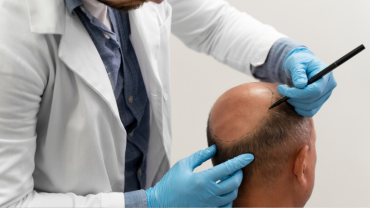What is Platelet Rich Plasma Treatment for Hair Loss?

Platelet-rich plasma (PRP) treatment is a hair-loss treatment where a qualified dermatologist draws and treats your blood to extract growth factors to use as an injection in your scalp. This article will explore:
• How platelet-rich plasma is prepared
• How long does it last?
• Other medications that work well in conjunction with PRP
• Possible side effects
• The cost of platelet-rich plasma treatment for hair loss
What is Platelet Rich Plasma Treatment?
PRP for hair loss is a three-step process performed by qualified dermatologists. They will draw your blood and process it before injecting it into your scalp.
PRP injections trigger natural hair growth by supporting the hair follicle with growth factors that produce thicker hair. The technique has been used since the 1980s for hair loss and is also often used for healing and restoring injured muscles, ligaments, and tendons.
How is PRP Prepared?
Conventionally PRP injection is prepared by taking 10-20 cc of your blood and processing it by spinning it in a centrifuge. The blood is processed in two stages, with each one separating the blood into its separate components and refining the serum until it is pure PRP. Special tubes with a single spin technique are also available that help in producing concentrated PRP. At Sarin Skin Solutions we use the best pyrogen-free, sterile and US-FDA-approved vials only.
A medical professional will extract about 10-20cc of blood from your vein using a similar process to providing blood samples when testing for health.
Blood samples are then stored in vacutainers (specialized test tubes) to prevent clotting. If regular test tubes are used, the technician will add an anti-clotting agent, like citrate dextrose to the sample. Anti-clotting agents prevent the platelets from clotting before they can process the samples.
Processing Blood with the PRP Method
Doctors will draw around 10ml of blood from your vein. Before they place the blood in the centrifuge, they will ensure the blood is at a temperature of 20 to 24 degrees Celsius. Blood is spun at high rotation per minute and no anti-clogging agents are required.
The centrifugal force separates the blood into three layers, with the bottom layer containing red blood cells, the middle layer (buffy coat) with white blood cells and platelets, and the top plasma poor layer (PPP).
Technicians remove the white blood cells and gather the pure PRP by spinning the buffy coat at reduced speeds. Some technicians may prefer to use a white blood cell filter in place of spinning.
Various stages of the preparation process can influence the quality of the PRP injection. Plus, some doctors slightly alter the formulation according to aesthetics, or the medical issues they are treating. This is why you should select medical professionals with the training necessary to use PRP specifically for hair loss.
How Does PRP Benefit Hair Growth?
Medical professionals discovered that high concentrations of platelets in areas of the scalp suffering from hair loss could promote hair growth by extending the growing phase.
Injecting affected areas with PRP triggers growth factors that improve the blood supply to the hair follicle pushing the newer thicker hair strands out.
When Will I See Results?
Most people receiving PRP will notice that less of their hair is falling out after around 1 to 2 months of treatment. In 2 to 3 months, you will see that hair loss has stalled significantly, and new growth by 3 months. Most will notice improvements in the mirror between 6 to 12 months. Dermatologists will take before and after photos so you can more easily track your results.
How Long Do PRP Treatments Last?
PRP results vary from patient to patient, so some may need to visit their dermatologist more often and for longer than others. When your follicles and scalp are responding well, you can get away with fewer treatments.
However, should they take a while to take effect, you may need to set more appointments to ensure you continue to benefit from the treatments.
Typical treatments will require 4-6 sessions timed over 4 weeks.
Your dermatologist may also recommend booster sessions every 6 months (from the date of the first session).
Are PRP Results Permanent?
How long your PRP treatments will last will depend on the type of hair loss you are treating, with the treatment delivering permanent results in some cases.
Telogen Effluvium
Telogen effluvium is a hair loss condition caused by a variety of conditions. Heavy metal or toxin exposure can trigger hair follicles into entering a long-lasting resting state. Severe injury, surgery, and blood loss can all result in hair loss through telogen effluvium. The condition also regularly afflicts pregnant women who can suffer with hair loss up to a year after giving birth. Medications like antidepressants, oral contraceptions, and hypertensive drugs have also been known to tigger about of telogen effluvium. Fortunately, PRP is a viable solution for this condition that poses minimal risk. The treatment is completely natural as it uses the patient’s own blood.
PRP for Androgenetic Alopecia
Androgenetic alopecia, or male pattern baldness and female patterned baldness, is not curable but it is treatable, growing body of evidence shows that PRP can have a positive impact. PRP benefits androgenic alopecia by improving blood supply to follicles. Increasing collagen and elastin around blood vessel for better support of capillaries. Six treatment session spaced between 8-12 months are needed for best results. It is important to keep taking medications as prescribed by dermatologist to further enhance the results. Lifestyle modification with cutting down on alcohol and high glycemic food improves results further. Smoking must be stopped.
Other Medications to Use Along With PRP?
Minoxidil- First used as a treatment for high blood pressure, researchers soon discovered that hair regrowth occurred in some patients taking minoxidil. Minoxidil acts by opening blood vessels that supply the hair follicle. Topical treatment with minoxidil is the go-to treatment for androgenic alopecia, with many choosing to improve results further using PRP. When stem cells in the scalp become dormant, hair loss occurs.
Redensyl is a topical hair treatment that targets human fibroblasts and stem cells from the demal papilla to reduce hair loss and improve hair growth. The treatment acts as a kind of molecular switch that reawakens stem cells to trigger another round of hair growth.
Finasteride and Dutasteride act by reducing androgens and improving thickness of follicles.
Anagain is a pea sprout extract that has undergone clinical trials for its ability to reduce hair loss by triggering the growth of hair follicles.
Are There Any PRP Side Effects?
There are hardly any side effects for PRP because it’s an autologous process that uses substances drawn from your own body. Ensure you receive PRP treatments only from qualified practitioners. Sterility is critical to success, so you should ensure you are always taking it by a qualified dermatologist. Check medical council certificate displayed in the clinic for this.
How Much Does PRP Cost?
The many different variables mean that it’s impossible to pin down an exact price. Your best option is to call our office and book a consultation to get an exact PRP cost and a recommended number of sessions.
-
Posted in
blogs


